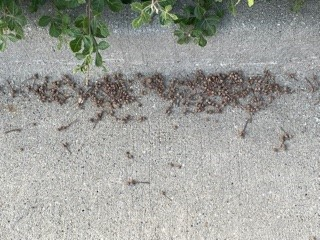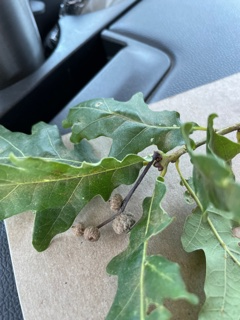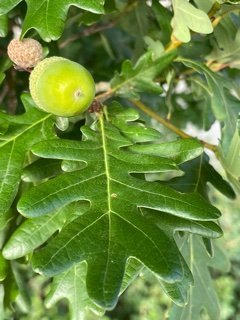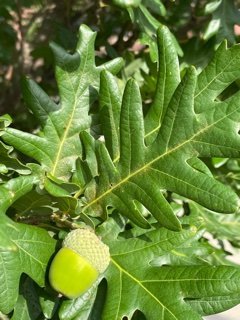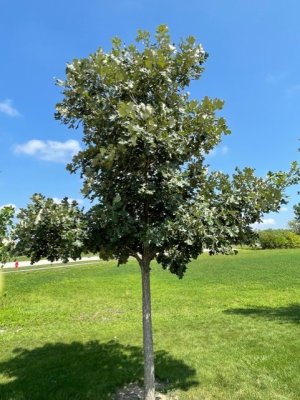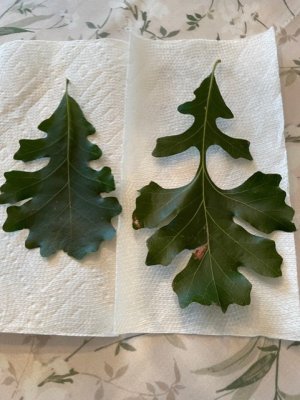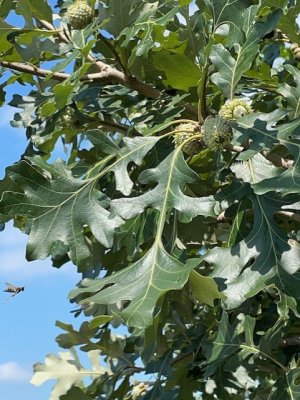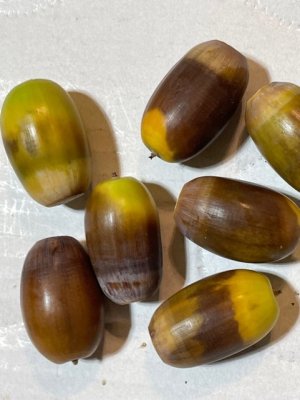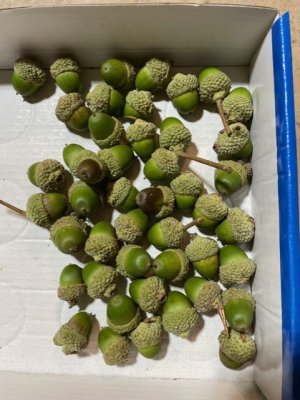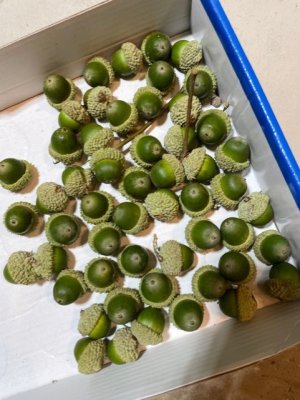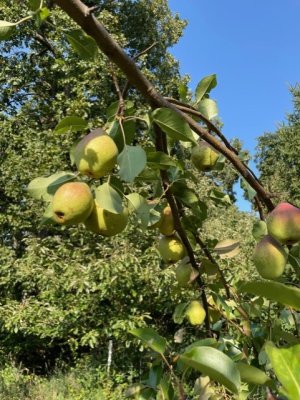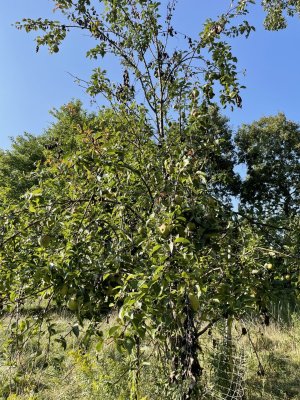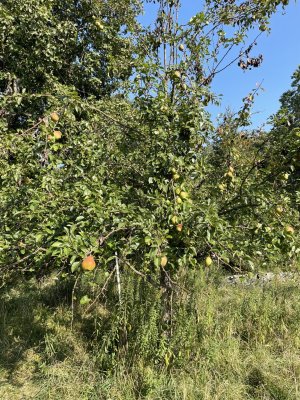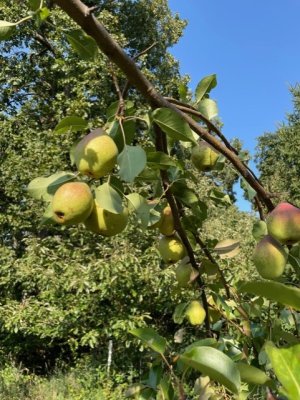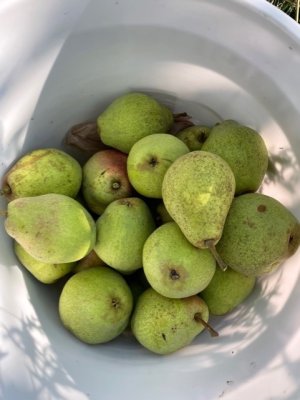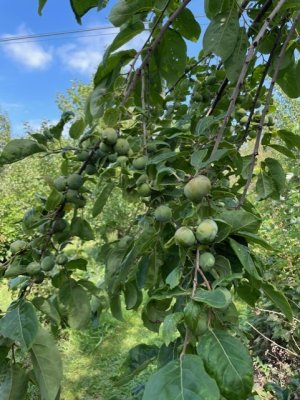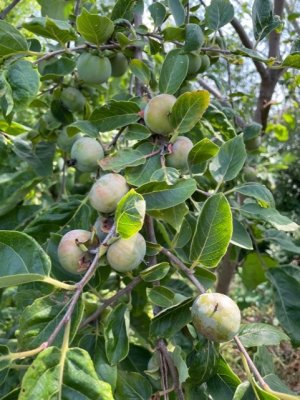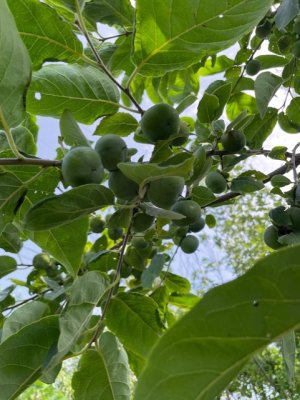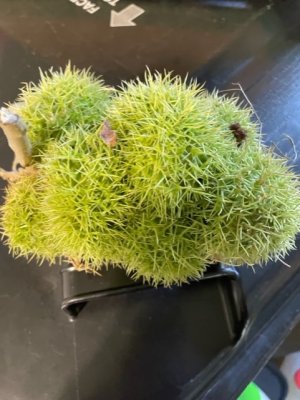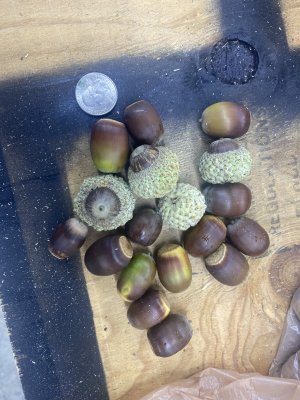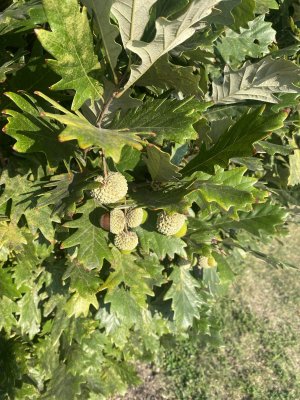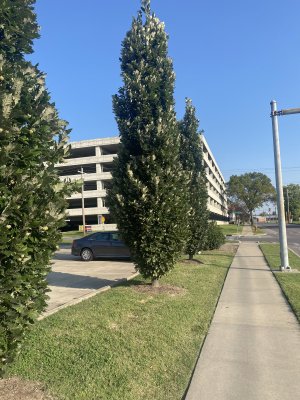-
If you are posting pictures, and they aren't posting in the correct orientation, please flush your browser cache and try again.
Edge
Safari/iOS
Chrome
You are using an out of date browser. It may not display this or other websites correctly.
You should upgrade or use an alternative browser.
You should upgrade or use an alternative browser.
The Woods ... mistakes I'v made
- Thread starter OakSeeds
- Start date
The attached photo shows a tree even smaller than the one displayed in Homrgrownbucks thread titled Columnar Oaks? Would you believe both of the leaves in the attached photo came from the same tree; it happens sometimes. The photos of the partially developed acorns and the leaves suggest the bur oak influence ... I expect them to fill out so as not to look so much like an overcup acorn (overcup oak typically don't have a fringed cup). Fruiting while this small suggest the tree is likely a hybrid ... hoping its another Schuette (bo X swo). Time will tell.
Attachments
Last edited:
People often ask: when can I start picking acorns? My rule of thumb is when you see squirrels eating them (they are essentially mature) or when you observe the first vestiges of brown on a couple of acorns. They will all turn brown within a couple of days after harvest. Today, my "picker" selected acorns off two swamp white oaks trees - probably 20-25 years old - that are loaded with exceptionally nice acorns in order to substantiate my selection criteria regarding ready-to-harvest. We'll get the bulk of the acorns off these vtrees in a couple of weeks. Further, one tree has such a heavy acorn load that the bottom half of the tree looks quite different from the top half (limbs hanging down).
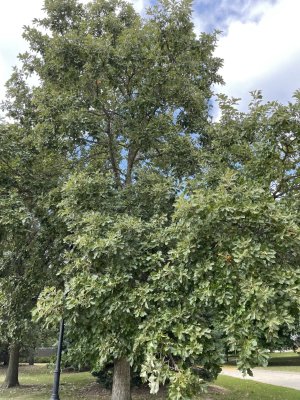
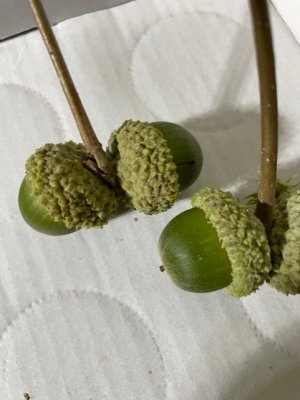
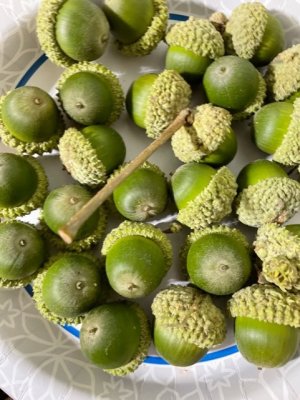



Last edited:
This next tree was heavily munched (the acorns) by squirrels over the past 7-10 days (limbs are not overloaded as much now). The green acorns in the box were picked today as well; I'll post a daily photo showing their color change A few days after their color change, they will be fairly easy to remove from the cap with no damage to the cap scar.




While nothing new- it’s my current stinger.
Not paying attention with mixing and going too strong for some maintenance cleanup in a clover plot. And in that same plot…
Seeding based on a single forecasted rain event… to which was the only rain for a months duration
Sent from my iPhone using Tapatalk
Not paying attention with mixing and going too strong for some maintenance cleanup in a clover plot. And in that same plot…
Seeding based on a single forecasted rain event… to which was the only rain for a months duration
Sent from my iPhone using Tapatalk
What experience has taught me about chestnut development and maturity dates .... nut size is influenced by the amount of rainfall/moisture available in August (remember, chestnuts love water but not wet feet; (commercial growers often use drip irrigation.) September rainfall influences chestnut bur opening and; therefor, nut drop. In general, the more moisture available in early September, the earlier the nut drop (as a/the chestnut(s) enlarges from rainfall - chestnuts are known for high moisture content), it eventually strains the bur with cracks appearing in the seams oif the bur (moisture swells nut(s) forcing bur to crack allowing heat to penetrate and dry bur which then opens fully). If harvested for seed, we pick them in mid-Sept (when burs are green and unopened at all). Avoids critter predation. Within 4-5 days, the burs have dried sufficiently for them to begin to open revealing nice brown chestnuts. On Thursday, we'll examine the 9-bur green cluster (picked Saturday PM) displayed above to illustrate the process. Point of post is ... harvesting chestnuts for seed, cut them off the tree after Sept. 20 (if they haven't opened). If growing for deer attractant, leave them be (and hope for lilttle moistuire in late Aug-early Sept and you'll probably have chestnuts falling until the 3rd-4th week of Oct.
Update .... Tuesday AM
We picked some chestnuts for seed on Saturday (see 9-bur cluster above) that were green on the outside (see 1st photo). Although I said I'd check them on Thursday, by today, they had all popped open to reveal nice brown colossal chestnuts. The 9-bur cluster; however remains pretty green with only the faintest hint of opening ... I assume it is the compacted mass preventing air circulation around some of the burs. Just a guess.

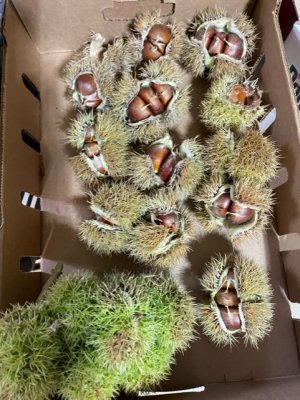
Update .... Tuesday AM
We picked some chestnuts for seed on Saturday (see 9-bur cluster above) that were green on the outside (see 1st photo). Although I said I'd check them on Thursday, by today, they had all popped open to reveal nice brown colossal chestnuts. The 9-bur cluster; however remains pretty green with only the faintest hint of opening ... I assume it is the compacted mass preventing air circulation around some of the burs. Just a guess.


Last edited:
The 9-bur colossal chestnut cluster was still a little green when I checked it yesterday. When I checked it this morning, much to my surprise, the chestnuts burs were heavily cracked and 24 not-so-colossal, colossal chestnuts were extracted. They are about the size of chinese chestnuts; however, they should make trees next spring that grow to produce very nice chestnuts. Top view of cluster, bottom view of cluster and final results.
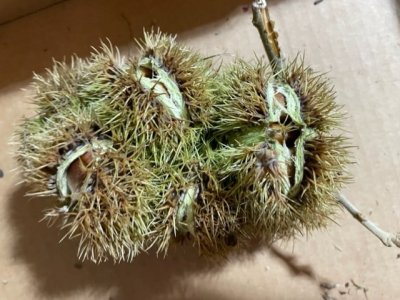
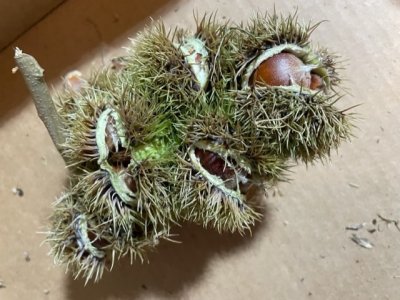
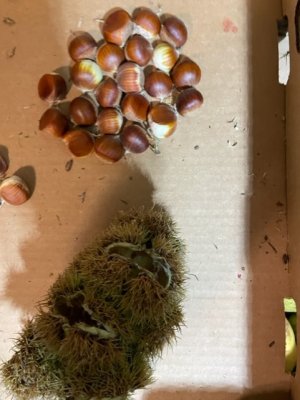



boardmaker
A good 3 year old buck
OakSeeds,
Any chance you could give an update on your use of columnar oaks as tree screens? Up until this point, we've mostly focused on individual trees, etc. I'd like to hear about how your screens are coming along. I'm planning on putting one in this coming spring with Regal Prince acorns I've collected. I plan on direct seeding with acorns that have shot radicles.
Have your screens completely filled in yet? What are some outcomes that you have experienced that you didn't expect, good and bad? Did all of your trees express the columnar shape/characteristics?
In my situation, the screen will lay in an East to West line which may become an issue once the trees get some serious height on them. I'd prefer N-S, but you can only play the hand you're dealt.
I'm building another exterior screen with ERC, but the idea of internal screens with the combination of food is really attractive. Especially one that will last a very long time.
Any chance you could give an update on your use of columnar oaks as tree screens? Up until this point, we've mostly focused on individual trees, etc. I'd like to hear about how your screens are coming along. I'm planning on putting one in this coming spring with Regal Prince acorns I've collected. I plan on direct seeding with acorns that have shot radicles.
Have your screens completely filled in yet? What are some outcomes that you have experienced that you didn't expect, good and bad? Did all of your trees express the columnar shape/characteristics?
In my situation, the screen will lay in an East to West line which may become an issue once the trees get some serious height on them. I'd prefer N-S, but you can only play the hand you're dealt.
I'm building another exterior screen with ERC, but the idea of internal screens with the combination of food is really attractive. Especially one that will last a very long time.
Great plan boardmaker, I prefer a E-W screen line whenever possible; plus, I believe in direct seeding in almost all circumstances. Regal Prince are pretty wide relative to some of the "tighter" columnar oaks; if you plant on 10 ft centers, you could remove a middle tree (among 3) as the trees grow outward. In one screen situation, we planted columnar oaks to fill holes between spruce trees. Planted acorns from 3 different sources and experienced a partial disaster (if one wanted a nice clean uniform line). 2 trees display excellent columnar shape; however, one tree has leaves twice the size of the other (different parent trees and genetic transfer). 3 trees are pretty gnarly (2 display more SWO parent characteristics than col. English leading to a not-very-tight shape) ... the 3rd is just downright garish in appearance, and one died (was a very nice tree). We may plant a 30-40 foot screen using Kindred Spirit col oaks next spring; I have located a source with some of the prettist trees I have ever seen and they produce lots of relatively large acorns in good numbers for young trees. I would suggest you avoid my mistakes by planting acorns from a single source if possible; nevertheless, there will always exist the possibility for genetic throwbacks on F-2 offspring. A couple of short screens we planted using single source acorns have produced trees retaining a tight columnar shape and good growth. Another mistake I made was caging them too tight in that as they grew outward, the concrete reinforcing wire cage inhibited growth Tree was reluctant to grow through the 6-ince squares and when it did, the deer browsed them heavily ( got a pretty high DPSM). In some sense it's like girdling your tree; it won't kill it but it will get a shape with a skinny bottom to the top of the cage. I'd plant as early as you can in the spring and be sure to add protection (from deer, rodents and bunnies).
There is a way to ensure they are all columnar; however, it entails a lot more work. I NEVER plant any tree seed in containers ABOVE ground ... I believe - to do it correctly - the maintenance is as bad as caring for a 2-month old child (regulating hydration can be a pain and limit your trees growth .. it's less of an iss +uefor a tree in a jug in the ground ... less wind problems and sun induced temp increase in container .. plus evaporation issues. That said, I have planted acorns/chestnuts in gallon containers (with holes cut out of the bottom and all 4 corners )... the containers are planted in the ground before planting the seed. Space them about 4-5 foot apart to give yourself some room when digging them for transplant.
Plant your screen line and watch for 2.5 yrs (april to april to april to october) and use you nursery trees (the ones in gallon milk cartons to replace any in the screen line you don't like) in late fall when they are dormant. Good luck my friend and keep us posted. I'm betting you produce a really nice screen.
There is a way to ensure they are all columnar; however, it entails a lot more work. I NEVER plant any tree seed in containers ABOVE ground ... I believe - to do it correctly - the maintenance is as bad as caring for a 2-month old child (regulating hydration can be a pain and limit your trees growth .. it's less of an iss +uefor a tree in a jug in the ground ... less wind problems and sun induced temp increase in container .. plus evaporation issues. That said, I have planted acorns/chestnuts in gallon containers (with holes cut out of the bottom and all 4 corners )... the containers are planted in the ground before planting the seed. Space them about 4-5 foot apart to give yourself some room when digging them for transplant.
Plant your screen line and watch for 2.5 yrs (april to april to april to october) and use you nursery trees (the ones in gallon milk cartons to replace any in the screen line you don't like) in late fall when they are dormant. Good luck my friend and keep us posted. I'm betting you produce a really nice screen.
Last edited:
On the pecan (trees) thread Bigbendmarine noted that lb-per-lb, Kieffer pears were the best mast producing trees he had planted. Without hijacking the "pecans" thread, I second his observation. The attached photos are pears off of discount trees from Lowes; don't believe any big time nursery is going to do any better. Some are almost too pretty and too good for deer food.
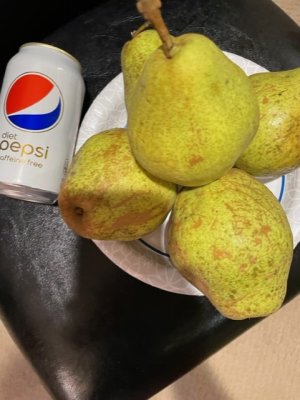
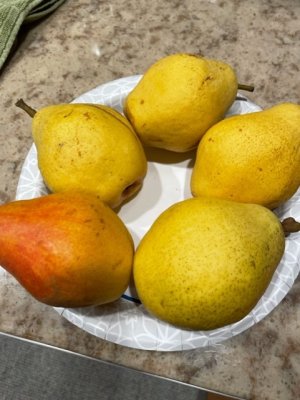


Last edited:
boardmaker
A good 3 year old buck
Thanks for the reply OakSeeds.
I was concerned about my east-west configuration, mostly because once they reach 30' tall that they would shade some of the foodplot directly to the north of the screen. On second thought, I don't believe it will be much of a problem. I might take advantage of it by planting some American Hazelnuts in the light shade.
Good point about the single source. When you say single source, are you talking about a single tree, or a single group of Regal Prince trees(around a parking lot)?
I have always kept my acorns I gather seperate by location, but not by tree.
I have 3 groups of Regals that I collect from. One group had a dismal crop this year from drought. Another was decent. And the one I just discovered was loaded. All were in drought, and none had irrigation. It's surprising to see the different tree reactions to the weather. Speaking of the one I just discovered, it's leaves looked like every Regal I've seen, but the acorns were on average quite larger diameter. And the cap covered the acorn more than ususal. So they have some different genetics in there somewhere. If I find a picture, I'll post it.
I have 14 acres at my house, and about 12 are in cattle pasture. That will end this winter. My plan is to make this my backyard habitat playground. I'm surrounded by cropground so cover is what is really lacking in my general overall area. I already had planned on doing a property screen but when I stumbled on this post about using these Oaks as interior screens, I knew that was what I was going to do.
I guess at some point I should start my own post about my property and projects instead of hijacking yours.
Thanks again for all the great real world info.
I was concerned about my east-west configuration, mostly because once they reach 30' tall that they would shade some of the foodplot directly to the north of the screen. On second thought, I don't believe it will be much of a problem. I might take advantage of it by planting some American Hazelnuts in the light shade.
Good point about the single source. When you say single source, are you talking about a single tree, or a single group of Regal Prince trees(around a parking lot)?
I have always kept my acorns I gather seperate by location, but not by tree.
I have 3 groups of Regals that I collect from. One group had a dismal crop this year from drought. Another was decent. And the one I just discovered was loaded. All were in drought, and none had irrigation. It's surprising to see the different tree reactions to the weather. Speaking of the one I just discovered, it's leaves looked like every Regal I've seen, but the acorns were on average quite larger diameter. And the cap covered the acorn more than ususal. So they have some different genetics in there somewhere. If I find a picture, I'll post it.
I have 14 acres at my house, and about 12 are in cattle pasture. That will end this winter. My plan is to make this my backyard habitat playground. I'm surrounded by cropground so cover is what is really lacking in my general overall area. I already had planned on doing a property screen but when I stumbled on this post about using these Oaks as interior screens, I knew that was what I was going to do.
I guess at some point I should start my own post about my property and projects instead of hijacking yours.
Thanks again for all the great real world info.
boardmaker.... you, and everyone else, are welcome - and encouraged - to post on any thread I start or continue. Shared information helps us all to gain new knowledge If you have enough acorns, I'd use those you referred to as ...."Speaking of the one I just discovered, it's leaves looked like every Regal I've seen, but the acorns were on average quite larger diameter. And the cap covered the acorn more than usual." Good luck and post when you have questions ... there are a lot of folks on this site who can provide you with useful information.
I made an interesting discovery on my road trip yesterday. I gathered acorns from a tree that is alleged to be a hybrid resulting from an overcup oak being pollinated by a bur oak. My picker and I picked both highly mature and some(maybe 40%) of green acorns still on the tree. None of the acorns were ground gathered (including the mature ones); everything was selected from the tree. If the acorns turn out to be something the deer will eat (can they get through the larger cap), it appears the tree might hold large acorns into November.
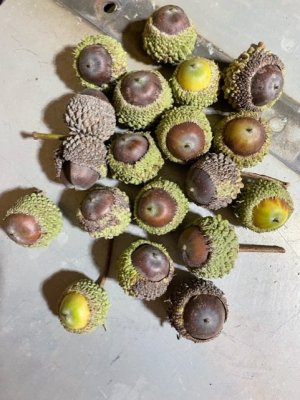

I have a couple of others finds to share; however, I have to provide pick-up service at the airport so I'll save those stories for another time.
I made an interesting discovery on my road trip yesterday. I gathered acorns from a tree that is alleged to be a hybrid resulting from an overcup oak being pollinated by a bur oak. My picker and I picked both highly mature and some(maybe 40%) of green acorns still on the tree. None of the acorns were ground gathered (including the mature ones); everything was selected from the tree. If the acorns turn out to be something the deer will eat (can they get through the larger cap), it appears the tree might hold large acorns into November.


I have a couple of others finds to share; however, I have to provide pick-up service at the airport so I'll save those stories for another time.
Last edited:
boardmaker
A good 3 year old buck
Here’s a few pics of the Regals I just found.
As the acorn matures, it’s much easier to pull out of the cap. This may help them be a later drop acorn.
Which gives me a thought. A Post Oak generally has a later drop than a White Oak or a SWO. If someone would make a columnar English/Post Oak cross and it kept the late drop characteristics it just might be the ultimate screen tree.
As the acorn matures, it’s much easier to pull out of the cap. This may help them be a later drop acorn.
Which gives me a thought. A Post Oak generally has a later drop than a White Oak or a SWO. If someone would make a columnar English/Post Oak cross and it kept the late drop characteristics it just might be the ultimate screen tree.
Attachments
Boardmaker ... I am afraid you haven't found a Regal Prince source (cross between a swamp white oak and a columnar English Oak); however, I would suggest what you may have discovered is a far better habitat tree. I've never seen a SWO acorn with a cap tightly wrapped and covering 2/3 of the acorn. I suspect you may have a hybrid oak tree created by a overcup oak being pollinated by a columnar English oak ... no wonder the acorns are of substantial size. Would be - I believe - a pretty rare tree and a very great find. Should make for a wonderful screen that shucks out lots of deer food as an attractant. Well done, my friend, well done.
Last edited:
BIGDHunting
A good 3 year old buck
I bought a couple of these same trees from Lowes. I planted them this past spring. Can you tell me how long your trees took to produce fruit like that?On the pecan (trees) thread Bigbendmarine noted that lb-per-lb, Kieffer pears were the best mast producing trees he had planted. Without hijacking the "pecans" thread, I second his observation. The attached photos are pears off of discount trees from Lowes; don't believe any big time nursery is going to do any better. Some are almost too pretty and too good for deer food.
View attachment 58087 View attachment 58088
Similar threads
- Replies
- 16
- Views
- 2K

